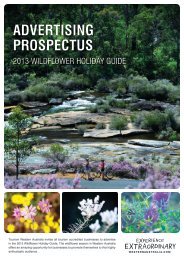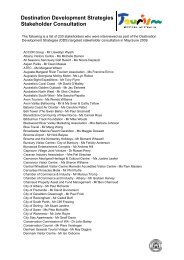A Strategic Approach to the Caravan and Camping Industry 2012
A Strategic Approach to the Caravan and Camping Industry 2012
A Strategic Approach to the Caravan and Camping Industry 2012
Create successful ePaper yourself
Turn your PDF publications into a flip-book with our unique Google optimized e-Paper software.
Camp with <strong>the</strong> Cus<strong>to</strong>dians<br />
Recommendation 5: Partner with Indigenous Australians <strong>to</strong> Develop <strong>Caravan</strong> <strong>and</strong> <strong>Camping</strong> Infrastructure on Indigenous L<strong>and</strong><br />
<br />
<br />
Tourism WA <strong>to</strong> collaborate with <strong>the</strong> Department of Indigenous Affairs<br />
(DIA), Aboriginal L<strong>and</strong>s Trust (ALT), Indigenous L<strong>and</strong> Corporation (ILC),<br />
Department of Education, Employment <strong>and</strong> Workplace Relations (DEEWR)<br />
<strong>and</strong> Indigenous Business Australia (IBA) <strong>to</strong> investigate a program which<br />
would facilitate <strong>the</strong> establishment of Indigenous <strong>and</strong> Private Enterprise<br />
Partnerships for expansion of caravan <strong>and</strong> camping opportunities on<br />
Indigenous L<strong>and</strong>.<br />
Engage best practice industry experts <strong>to</strong> develop infrastructure <strong>and</strong> deliver<br />
skills <strong>to</strong> <strong>the</strong>ir Indigenous business partners in return for a partnership on a<br />
lease <strong>to</strong> develop <strong>the</strong> assets. At <strong>the</strong> end of <strong>the</strong> lease, <strong>the</strong> Indigenous partner<br />
has <strong>the</strong> assets <strong>and</strong> <strong>the</strong> skills <strong>to</strong> move forward independently with a thriving<br />
business on <strong>the</strong>ir own l<strong>and</strong>.<br />
Issues <strong>and</strong> Risks<br />
A <strong>to</strong>tal of 364,445 km2 (14% of <strong>the</strong> state) is Indigenous-held 85 . “In terms of <strong>the</strong> size,<br />
Western Australia has by far <strong>the</strong> largest areas of native title l<strong>and</strong> of any Australian<br />
jurisdiction. Ninety two percent of <strong>the</strong> area of native title determinations is in Western<br />
Australia (Western Australia).” 86 Much of this l<strong>and</strong> is in regional <strong>and</strong> remote areas<br />
which are in high dem<strong>and</strong> by ‘nature based’ <strong>and</strong> ‘experience seeker’ caravanners <strong>and</strong><br />
campers. A significant proportion is also in <strong>the</strong> North of <strong>the</strong> state which appeals <strong>to</strong> <strong>the</strong><br />
intrastate market looking for somewhere warm <strong>to</strong> stay through <strong>the</strong> winter months. At<br />
present much of this l<strong>and</strong> is not effectively utilised or <strong>the</strong>re are insufficient facilities <strong>to</strong><br />
meet <strong>the</strong> dem<strong>and</strong>s of <strong>the</strong> majority of caravanners <strong>and</strong> campers.<br />
Much of <strong>the</strong> caravan <strong>and</strong> camping supply side deficit is in locations where <strong>the</strong>re is a<br />
significant Indigenous population <strong>and</strong> l<strong>and</strong>holding. Many Indigenous communities <strong>and</strong><br />
families have tried offering small scale camping on <strong>the</strong>ir l<strong>and</strong>, particularly in <strong>the</strong><br />
Kimberley with twenty or more small scale Indigenous operated campgrounds<br />
operating with varying degrees of success. Many of <strong>the</strong>se business opera<strong>to</strong>rs lack <strong>the</strong><br />
capital <strong>and</strong> commercial experience <strong>to</strong> reach financial viability or sustain real wages for<br />
opera<strong>to</strong>rs.<br />
85 Regional Indigenous L<strong>and</strong> Strategy 2007-<strong>2012</strong> Western Australia, Indigenous L<strong>and</strong> Corporation<br />
86 Http://www.hreoc.gov.au/about/media/speeches/social_justice/2007/IQPC_2may_2007.html<br />
Lack of clear succession planning <strong>and</strong> back up staff can often result in lack of<br />
consistency in service delivery, especially when cultural or family commitments divert<br />
attention away from <strong>the</strong> business. This results in negative impacts on reputation, as is<br />
indicated by many online user forums.<br />
Past grant funded investment in <strong>to</strong>urism infrastructure <strong>and</strong> marketing has shown little<br />
long term returns in terms of sustained employment (with real wages) or commercial<br />
success (without reliance on ongoing support). Fur<strong>the</strong>rmore a great deal of this<br />
infrastructure is underutilised or unutilised. Cash flow issues inhibit sufficient<br />
investment in repairs <strong>and</strong> maintenance which significantly reduces <strong>the</strong> lifespan <strong>and</strong><br />
effective long term use of assets with many being retired well before <strong>the</strong>y should be.<br />
The need <strong>to</strong> seek outside employment (due <strong>to</strong> insufficient income for wages) can<br />
often result in short or long term breaks in <strong>to</strong>urism operations <strong>and</strong>/or insufficient staff<br />
<strong>to</strong> maintain <strong>and</strong> grow <strong>the</strong> business resulting in a gradual decline or failure.<br />
Strategy<br />
Tourism WA could initially seek support through DEEWR’s Indigenous Employment<br />
Program <strong>and</strong>/or IBA’s Economic Development Initiative <strong>to</strong> engage a consultant <strong>to</strong><br />
investigate <strong>the</strong> viability <strong>and</strong> progress <strong>the</strong> development of an Indigenous Private<br />
Partnership Program for caravan <strong>and</strong> camping Facilities on Indigenous L<strong>and</strong>s. A<br />
successful program could deliver <strong>the</strong> following outcomes:<br />
<br />
<br />
<br />
<br />
<br />
As a first stage, it may be advantageous <strong>to</strong> select one region, such as <strong>the</strong><br />
Kimberley, <strong>to</strong> develop <strong>the</strong> strategy <strong>and</strong> identify suitable sites.<br />
Devise a model for delivering an Indigenous <strong>and</strong> Private Enterprise Partnerships<br />
for <strong>the</strong> delivery of caravan <strong>and</strong> camping facilities on Indigenous L<strong>and</strong><br />
Assess <strong>the</strong> financial viability of <strong>the</strong> proposed partnership model<br />
Consult with stakeholders <strong>to</strong> establish <strong>the</strong> long-term sustainability of <strong>the</strong> model<br />
<strong>and</strong> identify any opportunities or foreseeable impediments <strong>to</strong> <strong>the</strong><br />
implementation or viability (e.g. Aboriginal L<strong>and</strong>s Trust, caravan park Inves<strong>to</strong>r<br />
Groups etc.)<br />
Seek funding (if required) <strong>to</strong> support <strong>the</strong> development <strong>and</strong> delivery of <strong>the</strong> model<br />
A <strong>Strategic</strong> <strong>Approach</strong> <strong>to</strong> <strong>Caravan</strong> <strong>and</strong> <strong>Camping</strong> Tourism in Western Australia Page 96




![Annual Report 2002 - 2003 [pdf ] - Tourism Western Australia](https://img.yumpu.com/27124309/1/186x260/annual-report-2002-2003-pdf-tourism-western-australia.jpg?quality=85)
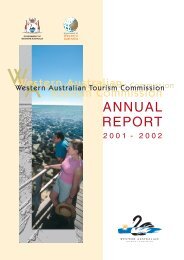

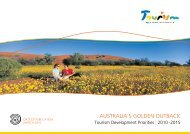

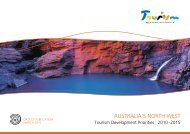

![Our Direction in China 2012 - 2015 [pdf ] - Tourism Western Australia](https://img.yumpu.com/27124271/1/184x260/our-direction-in-china-2012-2015-pdf-tourism-western-australia.jpg?quality=85)
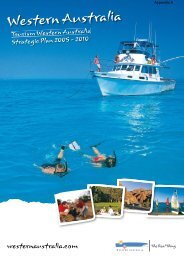
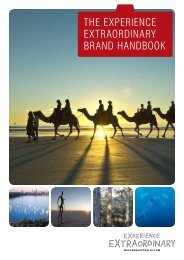
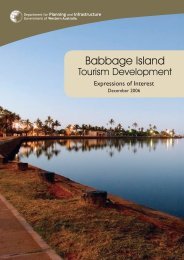
![Naturebank Program 2011 [pdf ] - Tourism Western Australia](https://img.yumpu.com/27124244/1/184x260/naturebank-program-2011-pdf-tourism-western-australia.jpg?quality=85)
